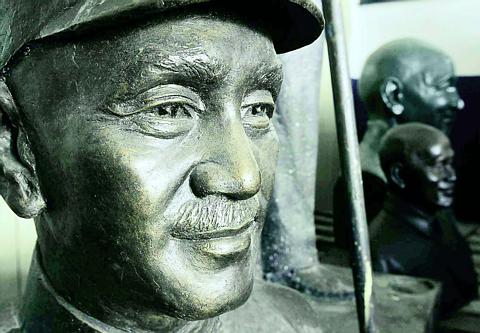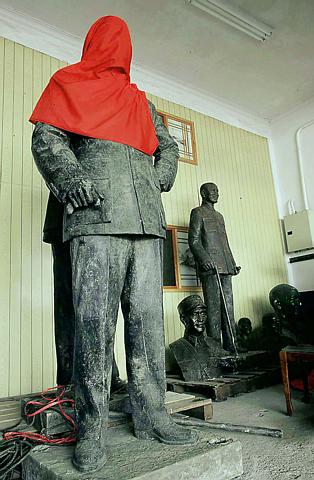Tzeng Rung-chien is a man with a mission. He's collecting the bits of Taiwan's past that nobody else wants -- Chiang Kai-shek statues.
Tzeng is mayor of Tahsi township, a small town an hour south of Taipei that attracts around 1.5 million tourists a year, most of whom come to pay their respects at Chiang Kai-shek's grave at the nearby Tsuhu Lake (慈湖).
He's a cordial man with a ready smile, and if you get a moment of his time he'll no doubt recount the story of how, last year, a visiting Russian television crew complimented him on his efforts to save recent political history from oblivion.

Photo by David Hartung
"They said, `That's what we should have done with our statues of Lenin, instead of just destroying them all,'" Tzeng said.
Tzeng has his work cut out for him. He reckons that Taiwan is home to some 43,000 statues of the former generalissimo. They're scattered around the island in schools, government buildings and parks; essentially wherever there's a public space in which people gather. For most Taiwanese today, they are anachronisms.
Chiang was president of the Republic of China on the mainland from 1926 until 1949, when his government was defeated by Mao and his indefatigable long-marchers. He ruled Taiwan with an iron hand as the president of the Republic of China in Taiwan from 1950 until his death in 1975. And for many Taiwanese his name is synonymous with all that is worst of the old-style KMT government.

The Chiang era was a time when the island's predominantly Taiwanese-speaking population received all their news and entertainment in Kuoyu, when martial law imposed travel restrictions on the local population, when all expressions of native culture and dissent were crushed by a government stacked with mainlanders claiming to govern free China.
But if Taiwan has come a long way from those "bad old days," the break with the past has been more evolutionary than revolutionary, a fact brought to life last week during protests by James Soong supporters in Taipei, many of whom were mainlanders.
So Chiang's smiling face still adorns the NT$1000 note (though there are plans to change that), and removing him from the public sphere is a sensitive process that if done too aggressively might spark off latent tensions between waishengren (mainlanders) and benshengren (native Taiwanese).
And that's where someone like Tzeng comes in.
"There are a lot of statues out there that no one wants," he says, "but people want to know that they're going to a good home. They want to know they aren't going to be destroyed."
Tzeng's "good home" is an art park, funded in part by the departments of transport and tourism and education, where he plans to display 200 of the best statues from around the island. The first of the statues, donated by the DPP Kaohsiung government, arrived at the park last month.
He says he got the idea when a dispute broke out at Taipei's Normal University between students who wanted a Chiang Kai-shek statue removed from in front of the university gates and conservative elements in the university faculty who thought it should remain.
For Tzeng, who is anxious to distance himself from any political motivations, the statues should be appreciated for their aesthetic qualities. "This is like putting a section of our history on display," he says.
"History is history, politics is politics. Some of these statues are works of art. They were created by artists."
Former journalist and now Tzeng's PR head, Wu Che-chung, agrees. "Chiang's rule is a fact," he says. "It shouldn't be a scar. We should be able to display his statues for aesthetic reasons.
"They were all hand-crafted," says Wu, as he stands in a garage attached to the local government buildings, where the 12 bronze statues that have been collected so far stand in a forlorn huddle.
"Back when Chiang ruled the country, he was like god. The craftsmen that made these statues had to be very careful to do a good job or they'd have been in deep trouble."
Wu points out how each of the statues shows Chiang at a different point in his life, in a different pose. The expression is the same in each: a tight-lipped smile, the strong chin jutting out purposefully.
"Look at this one," he says, pointing at a youthful bust. "This is Chiang back in China when he was a three-star general." And then he points to a life-size bronze that looks eerily like a terracotta warrior. "That's Chiang as President of the Republic of China here in Taiwan."
Tzeng and Wu are coy about what will happen to the thousands more Chiang Kai-shek statues around the island once their art park is complete in around two years time. But they are adamant that they shouldn't be destroyed.
"They're all works of art," says Tzeng. "We have to respect the people who created them."

On April 26, The Lancet published a letter from two doctors at Taichung-based China Medical University Hospital (CMUH) warning that “Taiwan’s Health Care System is on the Brink of Collapse.” The authors said that “Years of policy inaction and mismanagement of resources have led to the National Health Insurance system operating under unsustainable conditions.” The pushback was immediate. Errors in the paper were quickly identified and publicized, to discredit the authors (the hospital apologized). CNA reported that CMUH said the letter described Taiwan in 2021 as having 62 nurses per 10,000 people, when the correct number was 78 nurses per 10,000

As we live longer, our risk of cognitive impairment is increasing. How can we delay the onset of symptoms? Do we have to give up every indulgence or can small changes make a difference? We asked neurologists for tips on how to keep our brains healthy for life. TAKE CARE OF YOUR HEALTH “All of the sensible things that apply to bodily health apply to brain health,” says Suzanne O’Sullivan, a consultant in neurology at the National Hospital for Neurology and Neurosurgery in London, and the author of The Age of Diagnosis. “When you’re 20, you can get away with absolute

May 5 to May 11 What started out as friction between Taiwanese students at Taichung First High School and a Japanese head cook escalated dramatically over the first two weeks of May 1927. It began on April 30 when the cook’s wife knew that lotus starch used in that night’s dinner had rat feces in it, but failed to inform staff until the meal was already prepared. The students believed that her silence was intentional, and filed a complaint. The school’s Japanese administrators sided with the cook’s family, dismissing the students as troublemakers and clamping down on their freedoms — with

As Donald Trump’s executive order in March led to the shuttering of Voice of America (VOA) — the global broadcaster whose roots date back to the fight against Nazi propaganda — he quickly attracted support from figures not used to aligning themselves with any US administration. Trump had ordered the US Agency for Global Media, the federal agency that funds VOA and other groups promoting independent journalism overseas, to be “eliminated to the maximum extent consistent with applicable law.” The decision suddenly halted programming in 49 languages to more than 425 million people. In Moscow, Margarita Simonyan, the hardline editor-in-chief of the